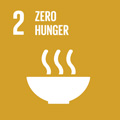- Docente: Ornella Francioso
- Credits: 6
- SSD: AGR/13
- Language: English
- Moduli: Ornella Francioso (Modulo Mod 1) Ornella Francioso (Modulo Mod 2)
- Teaching Mode: In-person learning (entirely or partially) (Modulo Mod 1); In-person learning (entirely or partially) (Modulo Mod 2)
- Campus: Bologna
- Corso: Second cycle degree programme (LM) in International Horticultural Science (cod. 6784)
Learning outcomes
Course Unit 1. Soil fertility (total 3 cfu). The students at the end of the course will be able to evaluate soil fertility from a physical, chemical and biochemical point of view. In addition, they will also be aware of how to manage soil fertility and increase it, if necessary, according to the productivity goal set and environmental indicators. Course Unit 2. Secondary metabolism of horticultural plants (3 cfu). The purpose of the course is to give students a basic understanding of the main biosynthetic pathways and chemical composition of secondary metabolites; the potential market use of these metabolites; and the eco-physiological function of such metabolites in plants.
Course contents
Course Unit 1. Soil fertility.
Biogeochemical cycles: Nitrogen: fixation, mineralization, immobilization, organication, nitrification and denitrification. Phosphate: immobilization and mineralization of phosphorus; Sulphur: reduction of sulphate and oxidation of Sulphur.Potassium, Calcium, Magnesium and Iron. Mineral and organic fertilizers and factors affecting their availability. Biostimulants and chelates. Recycling and use of biomass from agro-waste in agriculture.
Course Unit 2. Secondary metabolism of plants
Primary metabolism vs secondary metabolism.
The classes of secondary metabolites and functions:
Terpenes and biosynthetic pathway
Alkaloids and biosynthetic pathway
Phenols and biosynthetic pathway
Readings/Bibliography
Biochemistry of plant secondary metabolism / edited by Michael Wink Sheffield : Sheffield academic; Boca Raton, Fla.: CRC, 1999
Mengel K. and Kirkby E. A. (2001). Principles of Plant Nutrition. 5th Edition. Pp. 849. Kluwer Academic Publishers, Dordrecht, Boston, London.
Marschner H. (1995). Mineral Nutrition of Higher Plants. 2nd Ed. Academic Press
Teaching methods
The course consists of lectures (50 hours), seminars offered by researchers from other institutions to supplement the lectures and study visits to companies in the area
Assessment methods
The final assessment consists of an oral presentation on two topics selected in consultation with the teacher, focusing on soil fertility and plant secondary metabolites. The exam lasts approximately 20 minutes.
The grade is based on the student’s overall preparation, with particular emphasis on language accuracy, the ability to draw connections between the two topics, and analytical skills.
Students with learning disorders and\or temporary or permanent disabilities: please, contact the office responsible (https://site.unibo.it/studenti-con-disabilita-e-dsa/en/for-students) as soon as possible so that they can propose acceptable adjustments. The request for adaptation must be submitted in advance (15 days before the exam date) to the lecturer, who will assess the appropriateness of the adjustments, taking into account the teaching objectives.
Teaching tools
Topics presented during the lesson are shared with students in class and uploaded to Online Virtual.
Office hours
See the website of Ornella Francioso
SDGs




This teaching activity contributes to the achievement of the Sustainable Development Goals of the UN 2030 Agenda.
